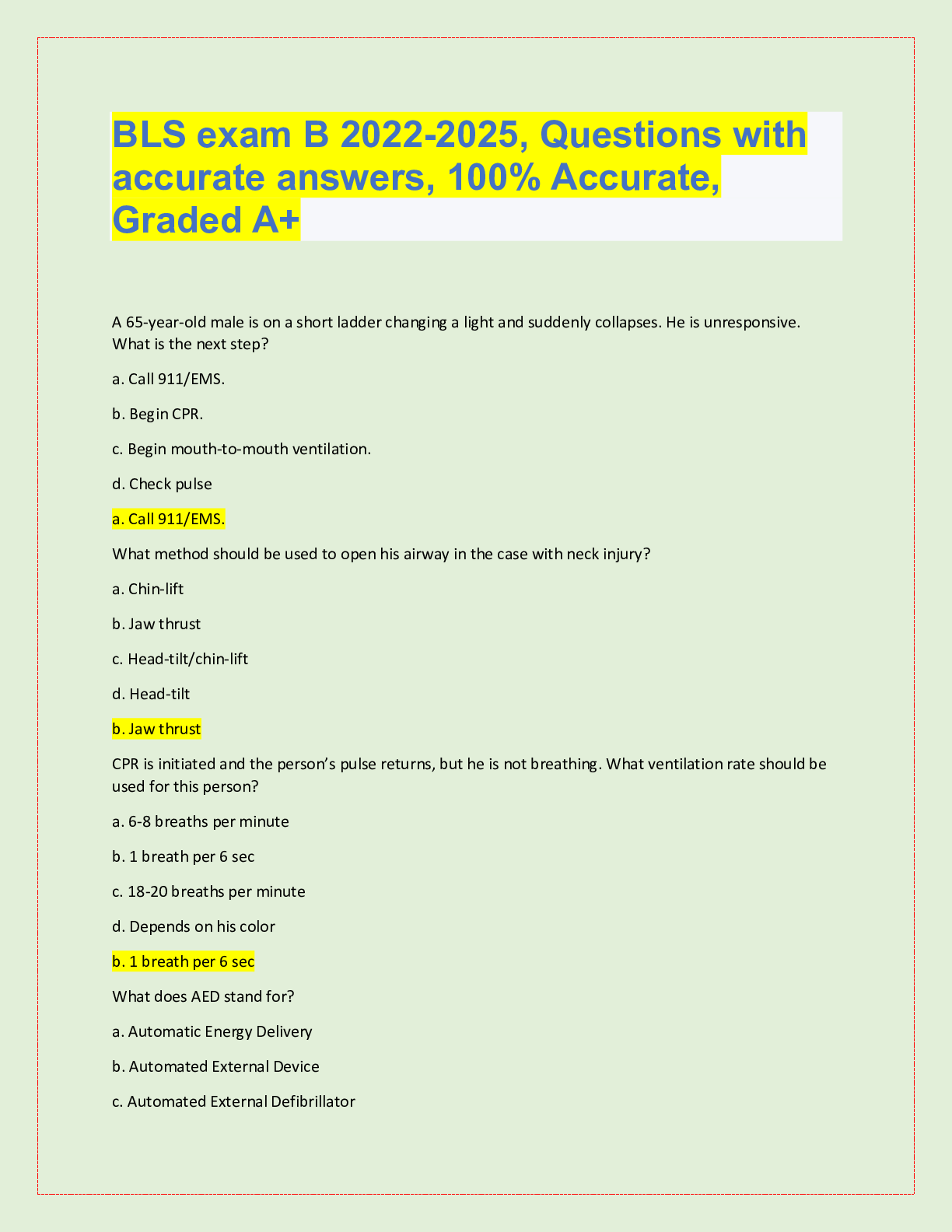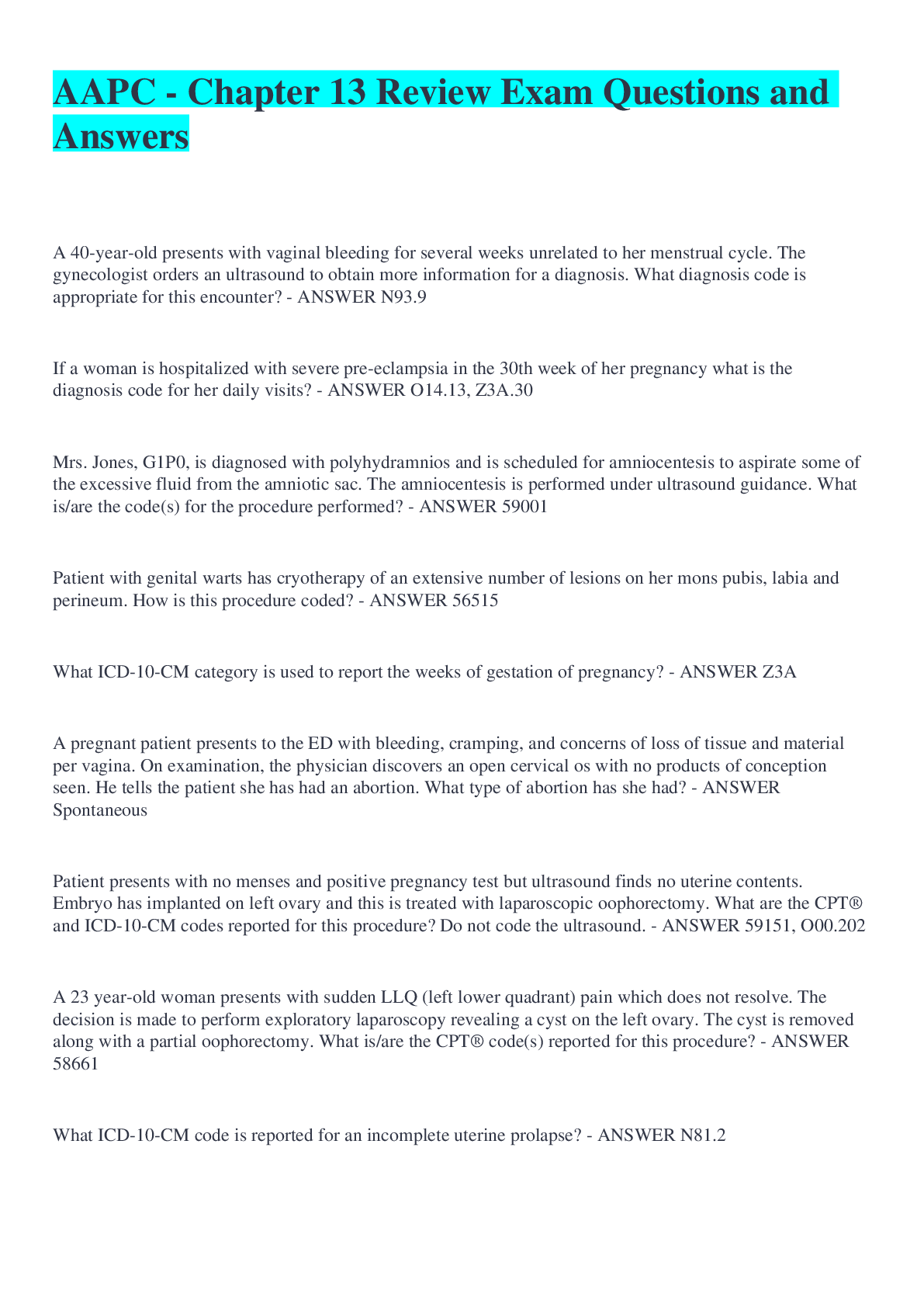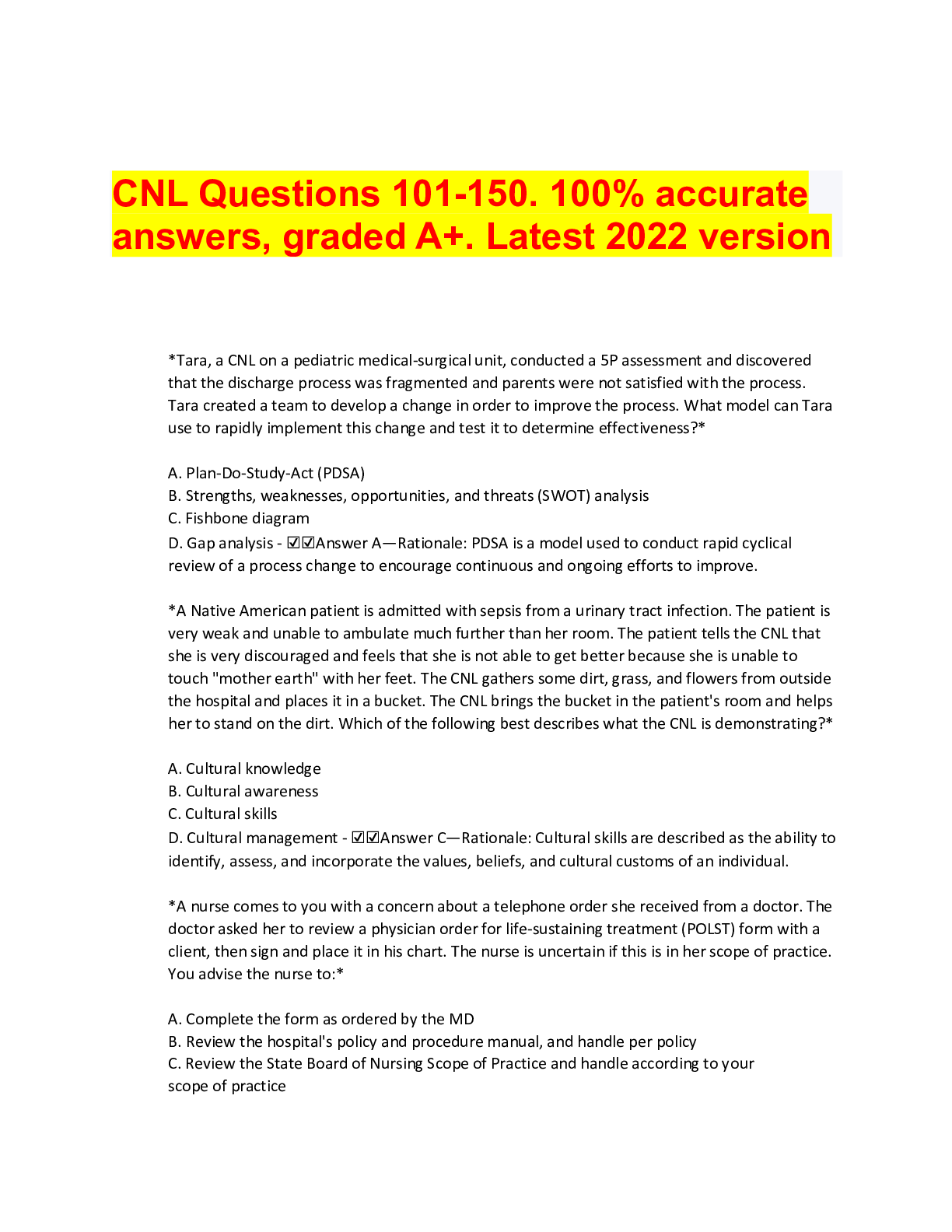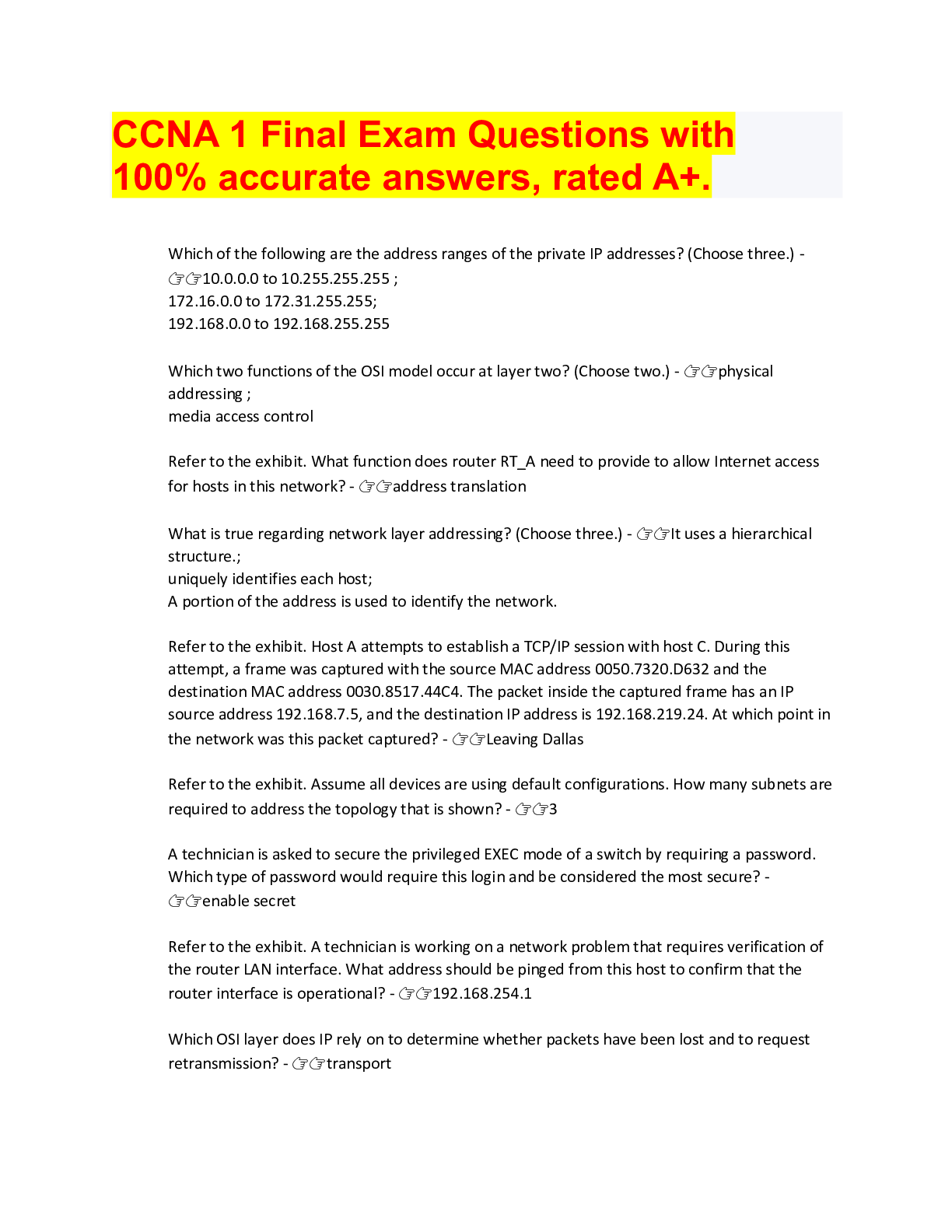*NURSING > QUESTIONS & ANSWERS > CSEP-CPT Written Exam - Core Competency 1, 2, 5 & 6. Questions with accurate answers, graded A+ (All)
CSEP-CPT Written Exam - Core Competency 1, 2, 5 & 6. Questions with accurate answers, graded A+
Document Content and Description Below
CSEP-CPT Written Exam - Core Competency 1, 2, 5 & 6. Questions with accurate answers, graded A+ What is Standards? - ✔✔-The ethics and best practices established by authority (how they want t... heir professionals to act) Standards are often organized within a code of conduct/ ethics What is Professionalism? - ✔✔-Conforming to the ethical and technical standards of the profession Name some examples of ethical standards: - ✔✔-Integrity, Initiative, Accountability, Fairness, Effective communication, Teamwork, Leadership, Learning Integrity - ✔✔-The quality of being honest and having strong moral principles Leadership - ✔✔-Motivating and organizing a group of people to achieve a common goal Accountability - ✔✔-An obligation or willingness to accept responsibility or to account for ones actions Fairness - ✔✔-The state, condition, or quality of being free from bias or injustice; evenhandedness Effective communication - ✔✔-A message was received with a mutual understanding of what was meant in the most efficient, clear, open and direct way Teamwork - ✔✔-Cooperative or coordinated effort on the part of a group of persons acting together in the interests of a common cause Initiative - ✔✔-The ability to assess and initiate things independently Learning - ✔✔-The modification of behaviour through practice, training, or experience Ethics - ✔✔-Objective, external, societal, consistent Morals - ✔✔-Subjective, internal, personal, may vary between individuals True or False - A person can follow ethical principles and NOT have any morals - ✔✔-True FHP Placement Code of Conducts: What is part of professionalism? - ✔✔-Dressing properly, arriving on time, punctual, maintains client confidentiality, follows cell/computer use policy, committed to safety of self and others FHP Placement Code of Conduct: What is part of Initiative? - ✔✔-Actively seeks out new work, participates without prompting, positive attitude, makes good use of down time FHP Placement Code of Conduct: What is part of Communication? - ✔✔-Clear and concise instructional skills with clients, excellent written and verbal communication with clients and coworkers, listens and responds to instruction from supervisor FHP Placement Code of Conduct: What is cooperation? - ✔✔-effective with coordination of tasks, helps coworkers, effective team player, adjusts to a variety of work conditions/ time shifts, respectful FHP Placement Code of Conduct: What is Problem solving? - ✔✔-Staying calm under pressure, demonstrates creative thinking, recognizes and corrects mistakes without prompting, displays skills, makes arguments on evidence based research What are the 5 employability skills for FHP placement? - ✔✔-Professionalism, Initiative, Communication, Cooperation, Problem Solving Regulated Professions - ✔✔-Professions with the government either provincially or federally, acts to protect the public Examples of regulated professions - ✔✔-Doctor, Physiotherapist, Kinesiologist, Massage Therapist What are benefits of regulated professions? - ✔✔-Leads to higher and consistent standards among professions (stable funding sources), work benefits, quality jobs, protected titles Unregulated professions - ✔✔-Professions that are forced to base information off the highest standard certifying body professional within the industry Examples of unregulated professions - ✔✔-personal trainer Consent - ✔✔-To give permission Informed consent - ✔✔-used in law to indicate the consent is based upon a clear understanding of the facts, implications, and future consequences. Express consent - ✔✔-Consent that is given directly in explicit words either verbally or written Implied consent - ✔✔-Consent that is inferred from signs, actions, facts etc. Conflict of Interest - ✔✔-a situation in which the concerns of two different parties are incompatible Conflict of interest example - ✔✔-Treating family member, beginning a close relationship with a client, supervises a family member on placement Confidential - ✔✔-intended to be kept secret Confidential: Personal health information - ✔✔-Identifying information about an individual in oral or recorded form that refers to the persons health, payments, personal information etc. True or False: You are legally obligated to disclose confidential information to the police right away - ✔✔-False: there is no legal obligation UNLESS there is a search warrant or court order What does a SOP provide? - ✔✔-A SOP provides a brief description of the activities and areas of professional practice What is scope of practice? - ✔✔-The scope of practice describes the procedures, actions, and processes that a person is permitted to undertake in keeping with the terms of their professional license. (what a person is allowed to do based on their education/ qualifications) What is the CSEP-CPT scope of practice? - ✔✔-TA professional with a minimum of two years college/uni coursework in specific core competency areas related to the exercise sciences from an accredited post secondary institution. Based on the CSEP-CPT scope of practice, who do they work with? - ✔✔-They work with "apparently healthy" individuals or those with a "stable health condition" who are able to exercise independently True or false - A CSEP-CPT is certified to use an ECG - ✔✔-False - they are not permitted to use an ECG for any purpose True or false - A CSEP-CPT is allowed to work with/ administer fitness to exercise populations with unstable med conditions? - ✔✔-False - must have stable medical conditions True or false - A CSEP-CPT is allowed to use any assessment protocol or design exercise programs that require maximal aerobic or anaerobic effort - ✔✔-False - a CSEP - CPT is not certified to use assessments that require MAXIMAL AEROBIC OR ANAEROBIC EFFORT True or false - A CSEP-CPT is NOT allowed to assess muscular strength by using maximal 1RM protocols based on resistance loads exceeding 90% of of the predicted 1RM - ✔✔-True - not allowed to exceed loads over predicted 90% of 1RM True or false - A CSEP-CPT is allowed to work with those under the age of 15 and over the age of 69 - ✔✔-False- must be between 15-69 True or false - A CSEP-CPT is certified to conduct pre-participation health screening assessment on all clients using evidence based tools and gather information about physical activity. - ✔✔-True True or false - A CSEP-CPT is certified to administer various fitness assessments on clients including submaximal aerobic fitness, musculoskeletal fitness, and anthropometry - ✔✔-True What does the CSEP-CPT scope of practice consider to be "apparently healthy" - ✔✔-Generally an individual who has not been diagnosed with any health conditions and does not have any overt signs and symptoms suggesting the development of any health conditions How does the CSEP-CPT scope of practice define a "stable health condition"? - ✔✔-Generally an individual who has been diagnosed with a health condition such as CVD, diabetes, etc and meets criteria that suggests they are medically managed, and the benefits of activity clearly outweigh the risks. What do you do if a client answers "yes" to questions 2, 6 or 7 on the PAR-Q+? - ✔✔-Immediate referral to physician for clearance What does the CSEP-CPT mean when they say a person must be able to exercise independently? - ✔✔- Generally means a client can be mobile on their own without assistance from another person What are the rules for working with other diverse populations? - ✔✔-Must have a stable health, and it's the CSEP-CPTs responsibility to demonstrate they have specific training that qualifies them to work with this group. What if a diverse population does not have a stable health condition? - ✔✔-NO, outside of scope of practice.. must be a certified exercise physiologist or medical practitioner True or false - A CSEP-CPT is allowed to perform procedure on tissue below the dermis? - ✔✔-False Deglegation - ✔✔-Involves controlled acts, since fitness professionals are not allowed to administer any controlled acts, they should NOT DELEGATE True or false - A CSEP-CPT can assign non delegated (non controlled) tasks to another qualified fitness professional provided disclosure to and consent from your client - ✔✔-True Is a kinesiologist a registered title? - ✔✔-Yes, you can only call yourself one if you are registered for kin. What is the best practice? - ✔✔-A method that has consistently shown results superior to those achieved with other means, and that is used as a benchmark. True or false - best practice is generic or general phrase for a process of infusing professional practice with research based knowledge? - ✔✔-True Evidence based practice (EBP) - ✔✔-emerges from evidence based medicine, which Sackett et al. (1996) defines as conscientious, explicit, and judicious use of current best evidence in making decisions about the care of individual patients How would you get the best evidence? - ✔✔-merging clinical expertise with the best available external clinical evidence from systematic research When does liability exposure occur? - ✔✔-Occurs when the injury is attributable to the actions of the fitness professional - you may have to pay the injured client "damages" Liability exposure: employment issues - ✔✔-inadequate staff training or recruitment procedures by employer Liability exposure: pre- exercise health screening - ✔✔-failure to provide proper client pre-exercise screening or assessment Liability exposure: exercise prescription - ✔✔-client sustains an injury or exacerbates an existing injury due to inappropriate exercise instruction Liability exposure: facility and equipment issues - ✔✔-Slip or trip hazards in a facility or failure to properly maintain/ service or secure equipment resulting in an injury Liability exposure: emergency action plan - ✔✔-failure to have a proper EAP in place, failure to properly train staff in execution or the failure of staff to follow procedures in place Standard of care - ✔✔-For any qualified exercise professional in Canada to provide "reasonably safe" programs and services to clients Reasonably safe - ✔✔-taking all recommended precautions to prevent foreseeable health and injury risks what is a foreseeable health risk? - ✔✔-medical conditions, risk factors that can lead to problems such as cardiac arrest, stroke, or insulin reaction what is a foreseeable injury risk? - ✔✔-conditions or situations that can lead to problems such as back injury, bone fracture or joint sprain True or false - Standards of practice = standards of care --> which would = best practice = meeting the ethical and technical standards of profession = professionalism and competency = following the code of conduct/ethics and best practices - ✔✔-True Scope of practice = scope of care - ✔✔-true Negligence - ✔✔-Failure to do something that a reasonable/ prudent professional would have done OR doing something they would NOT have done What are the 4 potential causes of injury of concern to the personal trainer? - ✔✔-- inherent risks - ordinary negligence - gross negligence - product defects/ product liability Inherent risks? - ✔✔-the risks are inseparable from the activity ordinary negligence? - ✔✔-fault can be attributed to either the facility or personal trainer or the participant gross negligence? - ✔✔-deliberate or reckless conduct (e.g. when trainer knows risks and does not take steps to correct it) Product defects/ liability? - ✔✔-Manufacturing of a product is at fault due to a defect in the product design or manufacture or due to inadequete warnings about their use Informed consent vss wavier forms - ✔✔-NOT the same thing, wavier is release of legal right to sue because of negligence... consent form is competent adult acknowledging what they are partaking in and agreeing to accept risks involved What are ways to maintain safety practices as a trainer? - ✔✔-equipment maintenance, proper instruction, form and spotting, EAP, Remote locations, educating employees and clients about these How long does a client have to start a legal matter against you based on an incident report log? - ✔✔-2 years What are some of the most common liability claims? - ✔✔-slips, locker falling, sun tan burns, fainting from over exertion, falling off treadmills What is the most dangerous machine in the gym? - ✔✔-Lat pull down Coronary heart disease, type 2 diabetes, breast and colon cancers, and shortens life expectancy - ✔✔- Physical inactivity increases the risk of these major chronic conditions Benefits of Physical Activity - ✔✔->physical and mental health >quality of life >well-being >aerobic and MSK fitness >body composition >sleep >mood >self-confidence >neuromuscular awareness >Opportunities for social interaction >academic performance >immune system >muscle and bone strength >insulin sensitivity >chronic disease management >life expectancy >balance >mobility <chronic disease <hypertension <blood glucose <blood cholesterol <overweight and obesity <stress <need for medication <risk of functional limitations <risk of falls and fractures <health care costs Barriers to Physical Activity - ✔✔-Lack of time Inconvenience Lack of self-motivation Do not enjoy exercise Lack confidence in their ability to be physically active Fear of being injured or have been injured recently Lack self-management skills (set personal goals,e tc) Lack of encouragement, support, or companionship from family and friends Lack of built infrastructure Health Determinants - ✔✔-Income and social status Employment and working conditions Education Physical environment Health Services Gender Social support networks Light Intensity Physical Activity - ✔✔->1.5 (10PT SCALE) >3METS Moderate Intensity Physical Activity - ✔✔-4-6 (10pt scale) 3-6METS Moderate to Vigorous Intensity Physical Activity (MVPA) - ✔✔->3METS *This level of physical activity is usually what the Canadian Physical Activity Guidelines recommends in order to achieve health benefits Vigorous-intensity physical activity - ✔✔-7-8(10pt scale) >6METS METS - ✔✔-Metabolic equivalent 1MET= 3.5mlO2/kg/min Sedentary behaviour - ✔✔-Any activity characterized by an energy expenditure of </=1.5METS Common sedentary behaviours include: watching tv, video gaming, computer use, driving, reading, etc. Potential Consequences of Sedentary Behaviour - ✔✔->risk of type 2 diabetes >risk of coronary heart disease >risk of premature mortality >risk of infavourable body composition >risk of high blood glucose level <fitness <self-esteem <academic achievement Health Related Fitness - ✔✔-Components of fitness that exhibit a relationship with health status (i.e., aerobic, musculoskeletal and functional fitness). Ability to carry out daily tasks with vigor and alertness, without undue fatigue, and with ample energy to enjoy leisure-time pursuits and to meet unforeseen emergencies. Performance-Related Fitness - ✔✔-Physical training for a specific task like a recreational sport or a physically demanding job Can be different than training for general health and fitness as it may include agility, speed, power and motor skill performance. Example: training to achieve a target time for a 10km run or interested in pursuing a physically demanding job Physiological Fitness Components - ✔✔-Metabolic Morphological Muskuloskeletal Health-related Fitness Components - ✔✔-Body Composition Aerobic Fitness Muscular strength and endurance Performance-related Fitness Components - ✔✔-Agility Balance Coordination Power Speed Reaction time Planes of Movement - ✔✔-Sagittal/medial: divides the body along the midline Frontal/coronal Plane: separates anterior from posterior Transverse plane: separates superior from inferior Joint Actions - ✔✔-Flexion/Extension ABduction/ADduction Protraction/Retraction Elevation/Depression Medial/Lateral rotation Supination/Pronation Inversion and Eversion of the foot Circumduction How many bones are in the body? - ✔✔-206 Different kinds of joints - ✔✔-Synovial joints Fibrous joints Cartilagenous joints Approximately how many muscles are in the body? - ✔✔-about 700 named muscles 3 main types of muscles - ✔✔-Cardiac Smooth Skeletal Skeletal Muscle Classifications - ✔✔-location, origin, insertion, shape, size, direction and function Sliding filament model - ✔✔- Behaviour Change Theories - ✔✔-Social Cognitive theory (SCT) Self-determination theory (SDT) Trans-Theoretical model(TTM) Theory of planned behaviour (TPB) Health action process approach (HAPA) Self-Efficacy - ✔✔-One's belief in one's ability to succeed in specific situations - a concept imbedded in most behaviour change models Four Sources of Self-Efficacy - ✔✔-Mastery Experience: successful experiences boost self-efficacy, while failure erodes it. Vicarious Experience: Observing peers succeed at a task can strengthen belief in one's own abilities Social Persuasion: Credible communication and feedback can guide someone through a task or motivate them to make their best effort Emotional State: a positive mood can boost one's self-efficacy, while anxiety can undermine it. Social Cognitive Theory (SCT) - ✔✔-proposes that people learn through their experiences. Includes notion of reciprocal determinism, which refers to the dynamic interaction between an individual (particular set of skills), their environment (social context) and their behaviour (response to stimuli). Self-Determination Theory (SDT) - ✔✔-contends that individuals have basic physiological needs - to independently solve their problems (autonomy), to master tasks (competence), and to interact socially (relatedness). Amotivation: no intention or desire to change External Regulation: individual is motivated by external forces (pressure from others) Introjected Regulation: individual takes on the behaviour without fully accepting it as their own Identified regulation: individual consciously values a goal as personally important Integrated regulation: goals are fully assimilated with self Trans-Theoretical Model (TTM) - ✔✔-Precontemplation>contemplation> preparation > action > maintenance Theory of Planned Behaviour (TPB) - ✔✔-Individuals will engage in a behaviour when they evaluate it positively (behavioural beliefs), believe that significant others want them to engage in it (normative beliefs), and perceive it to be under their control (control beliefs [Show More]
Last updated: 2 years ago
Preview 1 out of 34 pages

Buy this document to get the full access instantly
Instant Download Access after purchase
Buy NowInstant download
We Accept:

Reviews( 0 )
$11.00
Can't find what you want? Try our AI powered Search
Document information
Connected school, study & course
About the document
Uploaded On
Mar 14, 2023
Number of pages
34
Written in
Additional information
This document has been written for:
Uploaded
Mar 14, 2023
Downloads
0
Views
105














.png)









